Listen Here
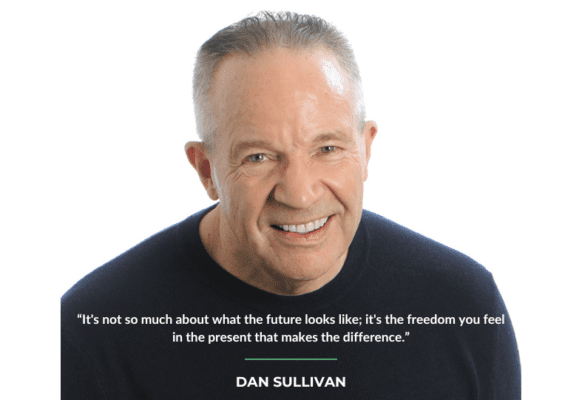 In today’s episode, we had the honor of hosting Dan Sullivan, the founder and president of The Strategic Coach Inc. With over 40 years of experience as a speaker, consultant, strategic planner, and coach to entrepreneurial individuals and groups, Dan is a true visionary in the world of business.
In today’s episode, we had the honor of hosting Dan Sullivan, the founder and president of The Strategic Coach Inc. With over 40 years of experience as a speaker, consultant, strategic planner, and coach to entrepreneurial individuals and groups, Dan is a true visionary in the world of business.
Dan’s ability to simplify complex concepts and provide actionable strategies will surely resonate, offering practical insights that can be applied immediately to enhance your business performance. His dedication to empowering entrepreneurs to embrace their unique strengths and leverage them for success is truly inspiring.
Throughout the episode, Dan shared his deep insights into entrepreneurship and his strong belief in its power to transform lives. He discussed the core principles behind his successful coaching program at Strategic Coach®, emphasizing its focus on helping entrepreneurs achieve their fullest potential both in their businesses and personal lives.
Dan also delved into his extensive body of work, he highlighted the importance of continuous growth and improvement, Dan’s wealth of experience and wisdom truly made this episode an invaluable resource for entrepreneurs striving for success in both their professional and personal endeavors.
Tune in and discover the secrets to unlocking your full potential with Dan Sullivan.
In This Episode
-
His background and over 40 years of experience as a speaker, consultant, and coach to entrepreneurial individuals and groups.
-
The two the concepts about freedom, both in business and personal life.
-
The significance of self-investment in personal and professional development.
-
Value of continuous learning, skill acquisition, and personal growth in entrepreneurship.
Welcome to today’s show on Wealth Strategy Secrets. Today we are joined by a special guest, Dan Sullivan. The ultimate entrepreneur who has coached over 7,000 entrepreneurs in his career and has over forty years of experience as a speaker, consultant, and entrepreneurial coach. He is focused on helping entrepreneurs succeed professionally and personally.
Dan has authored more than thirty books on entrepreneurship and personal growth. He runs The Strategic Coach Inc. with his wife and business partner, Babs Smith and operates in offices in Toronto, Chicago, and the UK. I hope you enjoy the show. Dan, welcome to the show.
Thank you, Dave.
Dan, I’m grateful to have you on the show to be able to share some of your thoughts and wisdom with our audience because it was a podcast like this that I listened to seven years ago, where I heard you for the first time. Since then, I’ve been a member of The Strategic Coach®.
You will never enter the gap if you can correct your future.
I’ve achieved 10x several times since then in many different assets of my life, in my freedom of purpose, my freedom of relationships, my freedom of money, and an exponential multiplier. I know the audience is going to enjoy this. Again, thank you for your time today. For those who aren’t familiar with some of your background, tell us how your journey started for you.
I’m one of the pioneers in coaching for entrepreneurs. There was a breed of coach when I started in 1974 but it was mostly corporate and it was back in the 70s. You had to explain what coaching was as it wasn’t because coaching was associated with sports, some art forms you had, coaches you had, dance coaches you had, singing coaches.
But the whole notion that entrepreneurs would have coaches was probably a pretty new thought. So I started as a writer in an Ad Agency in Toronto – a big agency that was number two in Canada. They had big accounts craft such as, Chrysler Capital, TD Bank which are big in the states. I was a writer. I was a good enough writer to make a living but it wasn’t a passion. I had mostly small accounts because they weren’t paying me much so they put me on the accounts where they weren’t making much money.
What I enjoyed about the relationship with the clients who were mostly family businesses was not much the Advertising aspect of it, but asking them questions about where they thought their company was going. What I observed is that my questions were appreciated by the clients of the agency’s customers. I like asking questions, so out of 74 launched, several faced difficulties in the first ten years, with a couple of bankruptcies, mostly due to receivables or going through a divorce. Then, around eight to four eventually settled in.
But the big breakthrough was meeting Babs Smith, who’s my partner. We had two abilities that complemented each other. She is marvelous at creating teams, teams of skilled people creating processes, and I’m good at being front stage. We took off from there so it was one-on-one coaching for fifteen years. Then in 1989, we’re in our 35th year, we put it into a workshop setting where we started with six. I thought I had died and gone to heaven.
You weren’t charging them full rates, but you were charging them 80% so you were getting a hundred from a client but you were getting six times eighty from six of them. To make the long story short, 35 years later, we have 18 coaches and we’re pushing 3,000 entrepreneurs. We do 600 workshop days a year in the schedule so it’s gotten out of hand.
How many entrepreneurs have you coached at this point in your career?
I was asked that question about a year ago. It took me a day or two to go back and look at the records, but personally where I’m the coach for the person, it’s about 7,000.
I’m sure you’ve learned a lot in coaching those 7,000.
I hope they’ve learned as much as I have.

One thing that I thought was interesting that you talked about a lot which is Thinking About Your Thinking. When I was new to coaching, I didn’t exactly know what that meant and where you were headed with that.
It’s fascinating because nowadays, I have people come up and compliment me about the way I think. They say, “Wow. I like the way you think, Dave.” Tell us a bit about what that means to you – Thinking About Your Thinking.
There are different kinds of thinking that people do, and thinking about their thinking is the least that they do. Some people think about things, and if you’re in a conversation with them, they’re talking about their things – their home, their cars, their cottage, the technology that they’re working with, and their life is mainly a world of things. Some people primarily think about people, and that’s why I think social media has been such a huge phenomenon that they interact from the time they get up in the morning until the time they bring each other up to date.
But it’s all about people. The first two levels mix – they’re talking about people in their things. Then there’s a third level which is thinking about thoughts. Pretty well your entire upper echelon of the educational system is people thinking about thoughts, but they’re not their thoughts. There you’ll have a professor at Harvard who’s an expert on President Lincoln.
He examines President Lincoln, Lincoln’s writings, his speeches, and his thoughts. But they’re not thinking about their thinking, they’re thinking about someone else’s thoughts and everything else. Those first three levels are 99% of people’s lives and thinking about thinking is on another level. Entrepreneurs are better at this to start with. Not know that they’re good at this, and they can’t quite explain why from an early age. When did you have your first clues that you wouldn’t going to be a good employee?
Back in grade school, and was disobedient.
I found the entrepreneurial road which is a fork. They take one path, the same road that 90% to 95% of the population follows, they know they want to get a good job and they want to. They may be in the course of a lifetime, have five or six different jobs, but they’re always an employee. The entrepreneur right from the beginning says, “There’s no way that I’m going to take orders from someone else.” Starting with parents and teachers. Where in Connecticut did you grow up?
Sadly, people know the town New Town, Connecticut because they had that shooting there in school which was tragic. But I grew up in a middle-class family. To your point, it’s so interesting, because I followed that recipe for success like many of us do, which is go to school, get good grades, and life is going to work and you’ll be fine.
I did the ROC program in the Marine Corps. I know you served in the army as well, Dan and it was complete bureaucracy, it was a hierarchy. It was this system that I struggled inside of that system I liked. I liked being on a mission but I didn’t like the system. Then when I got into Corporate America, it was completely more of the same which is this corporate hierarchy.
What was the industry?
I was in the tech industry.
I’ve done a lot of anecdotal research on this topic. When did you get the sense that you weren’t operating the way the other kids were, before ten years old? I would say easily you can see it before ten years old. The other things I noticed. How old are you now?
54.

When you reach self-actualization, it means there’s a sense of completion. You’re becoming who you truly are, as if that version of you already exists.
At 54, you’re more like you were when you were 8 years old compared to most people who aren’t entrepreneurs.
For sure.
There’s something about childhood playfulness that entrepreneurs hold on to that other people don’t. Tinkering with things and doing things that are not ordinary. Back to your original question where it started, we started in a workshop form. Every year, it grows. We’ve had 35 years, we’ve had two years where we broke even – we’ve had 33 years where we made a healthy profit. One of my favorite thing is making a profit, because it buys you time, resources, it and freedom.
Freedom is the key from making a profit, because when I went through these years of being in Corporate America and being in institutions, it was all about like this system – you were stuck in someone else’s machine. It was refreshing the first time I heard, you realize that it finally dawned on me that I was playing on someone else’s chessboard and I need to be on my chessboard that’s making my moves, and getting out of the gap and getting into the game.
As you referred to it, they said if you were playing chess, what would you rather be? Would you rather be the white or black piece? He says “I don’t want to be either of the pieces. I want to be the board. That’s what entrepreneurs do. It’s a great thing that I want to be the chessboard, and I want to make the rules.”
Exactly. You’re winning more than enough. We had our Annual Summit with Holistic Wealth, our Mastermind group. We talked a lot about creating a Holistic Wealth in your life and looking at all the different elements – including health, mindset, and all these different things. We did this cool exercise – we did a wealth visioning mind mapping.
It was fascinating to see what unanimously showed up for everyone. The answer to which was at the center of this, it wasn’t about how many zeros are in your bank account or how big your portfolio is, it was all about freedom. Tell us about your concepts around freedom.
There are two types of freedom. I’ll take you back to Connecticut, the school, your experience in the Marine Corps, and your experience in corporate life. One thing that drives you to be an entrepreneur is that you want freedom from what you don’t like about something in your past.
The vast majority of entrepreneurs that I have met their entire lives are still governed by freedom. They’re successful in year 54 and they have achieved things that they couldn’t have imagined 20 or 25 years ago. But they’re still trying to get away from something. Because you’re not thinking about what you want. When you get Freedom too, I’m totally in Freedom too, there’s something I’m getting to and I’ve got an update on that.
Your habit isn’t about reaching the destination; it’s about constantly striving to get there.
I’ve been talking about it for the last couple weeks so we can reveal it on this show. I was talking to a group and I had him draw a picture. I’m gifted visually, I am a boring artist. In the Ad Agency, I did a lot of layouts so I’m very good at that. I had him take a blank sheet of paper and turn it sideways – in the lower left-hand corner, I had him draw a little circle and put the word “here” and “there” next to the circle, then go to the upper right hand and put a big circle then draw a straight line from the little circle to the big circle with an arrowhead that touches the the big circle.
Above the line, I had him write the word “striving”. I said, “This is a picture of your life. You’re here and trying to get there. I’ve drawn a portrait of your life here, and there, always striving. You’ve been this way at ten years old, that way at 54.” Over the last 40 to 44 years for you, Dave, under the line you have strived, then underneath the line write in big letters word “HABIT”. You have a habit of being here and striving to get there. This is the strongest habit in your life; no other habit is as strong as this one. When do you think you’ll get there? Your habit isn’t about reaching the destination; it’s about constantly striving to get there.
It’s a nice way to put the habit because I might call it an addiction which is why I like to work with Joe Polish a lot.
I got off Adderall, I’ve been on a deal for years but it was sleep interfering with my sleep patterns so I did a sleep program. It was in Zoom, a great doctor, Dr. Michael Breus who lives in California. He is famous, he is a sleep doctor to the stars, and he said, “This chemical that you’re taking to get yourself up and get yourself focus destroys your sleep pattern. You don’t have to be rested, you take an Adderall and you’re okay. Then at night, you’re taking a sedative to go to sleep so you don’t have to be sleepy to go to sleep.”
You don’t have to be tired to go to sleep, and you don’t have to be rested to get up and do a full day’s work. He said, “If you would get off the Adderall and then we’ll get you off the sedative, it’ll be a bit of cold turkey for a little for a week or two, but all of a sudden, you’ll notice that your natural sleep pattern will kick in.” It made sense to me.
So the next day, I went off Adderall and that was eight months ago. I’ve had one Adderall tablet in the last eight months. All of a sudden, I kicked in. He was amazed at how quickly I went off of it and he said to me, “I don’t think you were addicted to Adderall, I think Adderall was addicted to you.” He said that there was some screaming and shouting on Adderall’s part when I have it because it felt it had a lifetime deal and I didn’t.

One thing that drives you to become an entrepreneur is the desire for freedom from what you didn’t like about your past.
You have wonder often whether the substance or whatever it is, you’re addicted to it or it’s addicted to you because you’re in a lifetime train ride. The thing that I did maybe made it easier ten years ago. I’ll be 80 in May. 10 years ago, I went up to that. I came up with this diagram about twenty years ago, but never showed it to anybody. I’m declaring myself there. I’m going to expand there to include more people and more freedom, but I’m not trying to get anywhere.
The last ten years have been by far the most creative and productive. I’ll bring the Thinking Tools because I want to go back to your question about Thinking About Your Thinking. In coach, we have 240 of them that have been created and there are ways of thinking about different entrepreneurial situations. But if you think through the tools that you’ve mastered in the program, what you’ll realize is they’re all questions.
I have a tool called ‘Your Best Decade Ever.’ I take people back ten years. I have them show all the decades of their life graphically with big arrows which they break into little arrows ten, twenty, thirty, forty, fifty years old. You’re in your sixth decade right now at 54, but if you go back to 44, have you created and produced more in the last ten years than you did before the last ten years?
I do this with about 300 to 400 entrepreneurs. To a person they say, “I’ve achieved more in the last ten years than I did.” If you’re 54 years old, you’ve achieved more since 44 years old – than you did before 44 years old. Then I asked him the question, “When in the future, would you want that not to be true that the decade that you’re in right now, you’re not creating more and producing more than you did up until that point?” Like I’ve achieved more since 70 years old than I did before 70. When I get to 90 years old, I will have achieved more since 80 years old than I did – that’s how you expand there.
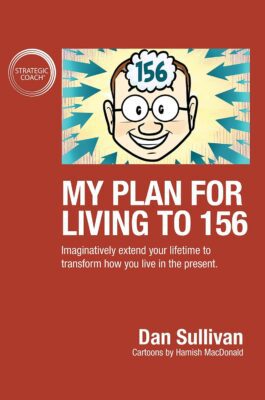
That’s an abundant way to live, Dan. It ties into your concept of Living To 156, maybe you can unpack that next for the listeners. What it does is, it changes the paradigm that we all live in the societal norm that at age 65, we’re going to retire.
Go to the departure, and start going to the departure lounge.
Exactly. You’ve completely changed that, so talk to us about that.
I did it for all the tools, an I do it for myself. I’m not out to what I do is, I never start creating a tool to sell to the entrepreneurs in the program. I do it because I’m dealing with something and need a new way to think about it. I experiment on myself. Since by being an entrepreneur, I’m defined as weird and might as well go the whole way. If you go to be weird, don’t do it. Don’t do it in half measures.
Do you think that there’s some parallel in your journey to Maslow’s Hierarchy and start moving closer toward self-actualization?
Except self-actualization is a manipulator. I go along with survival, safety, belonging, achievement – the first four levels. But when you get to self-actualization, that means that there’s a completion at some point. You’re actualizing who you are as if that already exists. You’re filling up space. I’m 95% self-actualized, but what happens when you get to 100% actualized?
It’s a bit of a gap term too. He created that for corporations, he didn’t create it for entrepreneurs. He lived in the 1940 – Abraham Maslow. I’ve changed it to self-transformation that wherever you are, you can transform it into something better. My best decade ever tool is that I’m achieving an enormous amount up to 70 to 80 years old, it was great. But when I turn 90, I will have created and achieved way more than I did in the first 80 years. I can’t see the point in the future where I would want to stop doing that.
It’s an abundant way of thinking. How are you able to develop that mindset to get there? Because 98% of the people frankly aren’t thinking that way.
It’s thinking about your thinking. How do you want to have it? Do you want to start declining physically, do you want to start declining mentally? When at the point after 50 years old, usually people decline. People are at their tops at 50. Then by the time they’re 60, they’ve lost energy, they’ve lost muscle, they’ve lost brain power, they’ve lost ambition. I asked, “Do you really want it that way?” I said, “No, you’re picking up on what others want—it’s not what you truly want.”
Let’s unpack this, what is 156? How did you come up with that number? What does that mean to you?
That’s a weird thought. I was watching a documentary, it was in 1987. It was a documentary that were doing on people who had been born in 1900. They were 87 years old and they had the aspiration to live to the end of the century. They wanted to live a complete calendar century. I was intrigued with it and they went into all the things. A lot has happened during the 20th century – the wars, great depressions, and all different things. I said, “That would be neat to live a complete calendar century.”
I’m sure changed because I was born in 1944 and I said, “I can only live 56 years during this century.” And I had the thought, “Why don’t you take the 56 and then do the calendar century from 2000 to 2100?” It was a whimsical thought. Then about a week after, I had another thought that if every time I think of my lifetime, I used the number 156.
The way I was thinking right then knew the family history. That it was high 80s, early 90s, grandparent’s parents. I said that I wanted to see if I could make this a normal thought. It took me about 3 years. The moment I think of my lifetime today, it’s 156. I’ll be 80 in May so I’m a bit past halfway and my brain’s worked out. The complete logic to that, you got a ton of time ahead of you.
Babs and I were married at that time, we got married in 1866. Three years in, I’ve got a thought and I said to her “I have this thing about living to 156.” She thought about it for about twenty seconds and she said, “Then I’m going to live to 149.” Because she’s seven years younger. I said, “Whoa” She didn’t question it, she didn’t bring up any objections or anything. That was in the 90s so it’s 34 years ago.
Then the program had started. I was creating Thinking Tools. You remember the diagram? That’s because it’s the first hour of The Strategic Coach®. This is when you’re born, this is the age when you think you’ll die, we don’t even think about it; we just ask at what age will we die. Let’s say somebody puts down at 85; let’s talk about 84, how do you want to be physically, mentally, financially, how do you want the quality of your relationships, your assessment of the life you’ve lived up until now?
Everybody answers the same way. “Great physical shape and lots of energy. You got all my marbles – financially, no problems, totally taken care of and lots of supportive friends. Think I’m happy with the life I’ve lived.” It’s the same, everybody answers the same way. I said, “So you say you’re going to die at 85, but you described how you are at 84? What do you think the chances are being the way you are at 84 and you die at 85?” They said, “I would.” So how much longer? They said, “Twenty to twenty-five years.” I always do it with one person. Then everybody else creates the same form. Then I shook his hand and said, “You’ve been with us an hour and I bought you 25 years.”
Wherever you are, you have the power to transform into something better.
How about that for ROI? You can go home now your work is done.
Where else can you get something like this – instant return? But you did. What was it like when you did the exercise?
It was fascinating. The trajectory on this one is I did the same thing; I’ve got some genetic issues in my family. I was thinking maybe about 89 years old is what I might make it to. Then I ended up adding some years on. I got to the number of 116. Some people have called me out because in my last book, I put 116 as my number. Since then, I’ve boosted the number so I’m now up to 146 because I think that my mindset has expanded.
Then the things I’ve already done – I’m five weeks from doing stem cell injections in my knees and I would talk about this a bunch, but what a game changer are the stem cells, the technology, and those things that are available. But the biggest thing, I’d have to encourage people out there to think about what’s been massive is whatever the number comes up to be, it’s expanded my present moment.
It’s not much what the future looks like as what the freedom you feel in the present that makes the difference. I’m sitting here and most people at 79 almost 80 aren’t buying green bananas because they don’t know whether they’ll die before it gets ripe. They’re making no new plans, they’re establishing no new projects, they’re establishing no new relationships. Because they’ve got this thought in their mind. But if you moved from 89 to 146, you’ve added 57 years.
If it goes on, because that’s 93 years old that I created that tool. People went wild with it and said, “This changes my thinking about everything.” I said, “We have a number.” My theory is that everybody’s got that number whether they’ve written it down on a sheet of paper and not. There’s this it’s actuarial tables – it’s family history, and relationships, but that’s not what you should be thinking. You’re taking the information from outside. If you could.
The medical means were available. The scientific-technological means were available that you could live to the age that you wanted to. What would be the age? People say, “I don’t know if I can do that.” I said right away, “Who cares what it looks like to other people, who cares what other people think about it. What’s important is what do you think about it.” Then they crack through and say, “I’d have to change how I’m living right now, how I’m eating, how I’m exercising, and who I’m hanging out.”
Because if you’re 54 and all the people you’re hanging out think they’re going to be dead before they’re 80, they’re already dying. Don’t hang out with a bunch of people who are on a downward slope. You can’t be on an upward slope if you’re hanging out with people who are on a downward slope. When you ask a question like that, it brings up a lot, because it’s a big question about your entire life. When you change how you view your life, everything in it changes.
Absolutely. This ties to a concept that we talk about a lot. You are your greatest asset. You are your greatest asset anytime you can invest in yourself, whether it’s through your health, your mindset, coaching, relationships, and your environment. I love Joe Polish’s metaphor of thinking like you’re a million-dollar racehorse. You’ve got to take good care of it. What do you think about investing in yourself as an asset?
You either do or you don’t. There is a difference between investments and costs.
That was going to be my next question, how do you invest?
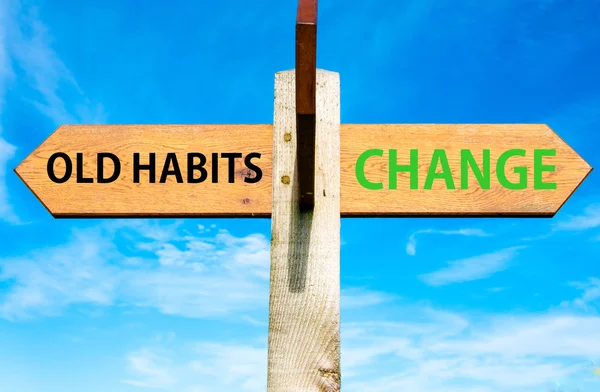
You are tomorrow what your habits are today. If you don’t change your habits today, nothing will be different tomorrow. You can project this as far into the future as you want; without changing your habits today, there can be no change in the future.
The thought occurred to me, this was a half a year ago. There’s a thinking tool in this, that’s where how they show up. They bother me for about three months. I created a tool but suddenly realized that I’m the only human being during my entire life that I have direct access to. I don’t have direct access to you, I don’t have direct access to Babs. There’s a universe that Babs lives in that I know a little about.
But this one I know a lot about the universe that Dan Sullivan lives in. So I thought that I’m all I’ve got to work with, and it comes down to habits. You are tomorrow what your habits are today. If you don’t change your habits today, nothing’s a different tomorrow, and that you can project as far into the future as you want. If you’re not changing your habits today, there’s no change in the future.
I put a lot of emphasis on habits. These are my investments. I’m in a neat role right now because about four months ago, it was. I’ll talk about this afterward because it has to do with stem cells. I said, “I’m going to create a scorecard and the scorecard will list habits that are good for me.” But these are changes I’m going to make. The first change was I realized as it relates to my health, and as it relates to nutrition, I never get in trouble with what I eat at meals, I only get into trouble with what I eat between meals.
With meals, usually I’ve got witnesses. But between meals, I don’t have any witnesses. So I said, “I’m not having any snacks.” I get to eat three times a day, it’s a sit-down meal. In the first five or six weeks, I established that as a habit. I’ve been on it now for about four months and it’s easy. Then I created a scorecard for myself and gave it every time I go between meals. When I don’t have a snack, I get one point. So I get four points because it gets overnight too, overnight is the easy one.
Then I thought, “What other habits?” I’ve added a whole bunch of habits. The first week, I got a score of about 21. Now the score I’m getting in a week is about 250. I’ve added other habits and I’m on a roll. I’m focusing on one habit at a time. I put it in place, and I don’t need five or six weeks to do it. If I go for ten days and looks like it’s getting a footing, I add another habit.
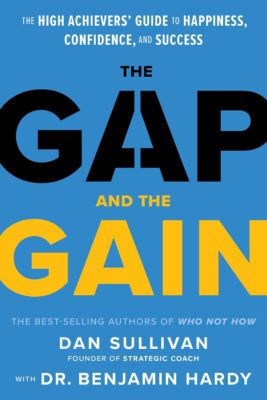
One thing that relates to another tool in Strategic Coach® is The Gap (and The Gain). You will never go into the gap if you can correct your future. The gap is like, “I should have done this but I didn’t do that. I didn’t do it, so I feel bad about myself.” I said, “I didn’t do it today, but in the future, it’s going to be a habit. I’ll postpone the correction into the future, which is easy if you’ve given yourself a lot of future.”
That’s interesting. I can see why that’s in the weekly planner to have all of those habits that you’re constantly thinking about. It’s such a dynamic process as you say, you’re on this journey that has no end. It’s all about creating those habits and how you live your life today intentionally.
What’s the big thing for you going forward is how you are expanding, and you’re there.
I think about this all the time; it’s in all different dimensions of my life from health. I’m healthier, I’ve done Ironman and marathons, but I feel healthier than I ever have in my life. I’m much more well-rounded now. I am always investing in my health, in my relationships, trying to expand the poor freedoms, and thinking about those.
Trying to serve other people – how we can create a bigger impact for others to get these types of insights, so that they can be inspired, other people can learn and go to the next level because then the impact becomes exponential – they start teaching that to their families, peers, and colleagues; and we can make the world a better place.
At least our part of the world.
Exactly. Dan, what’s your reveal? You mentioned you have something coming up, that you’ve been talking about for a few weeks.
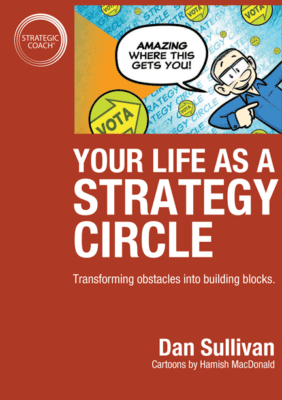
You’ve been doing The Triple Play, right? It is next to The Strategy Circle, it’s the greatest tool I’ve created. I created The Strategy Circle in 1982. For our listeners or watchers, it’s got a code. It’s Vision, Obstacles, Transformation, and Action (VOTA).
There’s a question that triggers this, we call it the R-Factor Question, and you say to someone if we were having this discussion. It was three years in the future. Today is the 12th of March, let’s say it’s 2027, and we’re having a discussion. You’re looking back over the three years to today. What has to happen in your life during those three years for you to feel happy with your progress?
It’s an interesting question because if they accept the question and the answer, it means they’ve accepted the relationship. That’s why we call it the R-Factor Question. Then you ask them more questions and they say, “What are five goals you have to have?” It’s this, and they have dangers they want to be eliminated.
They have opportunities they want to capture, they have strengths they want to maximize, and then you say, “What are the obstacles right now? What are the obstacles that prevent you from getting to those?” They lay them out, and then you say, “Is it a decision you have to make to get past the obstacles?” Something you have to communicate is something you have to create, it is something you have to take action.
It’s a vision, obstacle, transformation, action. That’s a great tool. Every other tool is a descendant of that original tool. I have this Triple Play and what I’ve discovered is we have the free zone; we have three levels of the program, we have a signature, we have ten times and we have a free zone. The free zone is a different realm and that’s where you as an entrepreneurial company are collaborating with another entrepreneurial company, but no money is exchanged and no shares are exchanged.
You put your two capabilities together to create a third thing that nobody in your industry, their industry could have ever created. It’s a brand new free zone value creation and you don’t have any competition. The whole thing is to get collaborations where you’re eliminating competition. It’s good, but what we’ve discovered is the best collaborations are three people. They have three different capabilities and you put these capabilities together. All of a sudden, it goes crazy. That’s why I’m introducing that on Thursday. I had The Triple Play for a couple of years, but now I’m using The Triple Play to create collaborations.
I love that. I can’t wait for that one.
You’ll get it.
That sounds great.
All you have to do is write another check.
Dan, if you could give one journaling piece of advice to the audience about how they could accelerate their journeys. What do you think would be?
A journal. I turned my life around; I mentioned my divorce and bankruptcy were in 1978. One of the bankruptcies happened on the same day when I was divorced. I had about three or four months to think about it. The reason why I’m in much trouble, first of all, it’s self-inflicted and nobody else is to blame for this, that I’m not telling myself what I want.
Most of us live our lives based on what we need and feel the need to justify it. But wanting is a realm of its own—a free zone.
I said, “I’m going to set a goal for the next twenty-five years. Every day, I’m going to write in a journal what I want.” That was at the end of 1978. At the end of 2003, I completed the project. It’s 9,131 days and except for 12 days, I did it every day. All my life I’ve created my partnership and marriage with Babs.
My Strategic Coach® all came because I did that. When you say what you want, don’t say because you’re trying to tell a story to the world. Just say, “I want this. No explanation.” I want this over almost 10,000 days. The only requirement is you have to write one sentence per day.
If you want to write a whole page go ahead, but you have to do at least one sentence. That will instantaneously change people’s thinking. Most of us live our lives out of what we need and you have to justify that. But wanting is a realm, and wanting is a free zone.
I’ve worked extensively on my one hundred Be Do Have list. I also learned a nugget from you a couple of years back on a podcast. You were talking to Joe and I always journal every day as well after I meditate. I have the most clarity of my thoughts. I started to expand that into all of these thinking exercises and started drawing pictures. It leveled up my journaling.
You were thinking about you’re thinking. It’s a separate realm. Most people never do anything about their thinking unless they have a crisis in their life. All of a sudden they say, “Why did that happen?” The answer to that question is you’re in the realm of thinking about your thinking. But most people don’t like crazy situations so they associate that type of thinking with crisis have ever been there; where you’re talking about something like we talk about normally in Strategic Coach®. The people around you who are not used to this say, “You’re going deep here, aren’t you?” I said, “I prefer deep to shallow.”
Dan, this has been a pleasure. Insightful as always. I can’t thank you enough for sharing your wisdom with many others out there. Being a hero to me and many other entrepreneurs out there. If people would like to learn more about Strategic Coach®, what is the best place?
Aspire to be a hero. It’s good for you. We have a great website StrategicCoach.com and you go there, we have lots of resources – we have books, podcasts. I have lots of interviews. We have stories about what entrepreneurs are doing with Strategic Coach® tools and different kind of lives are leading. We tell you about the program and how to get hooked up with it.
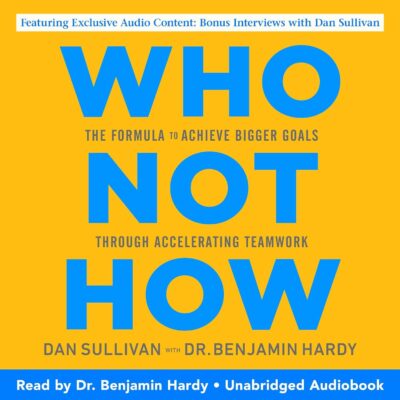
If you want to go a bit deeper, I would do the journaling. Get a journal and start saying what you want. But don’t just say “I want this.” Because you’re inventing a fictional story. The truth is you want it because you want it. The more that’s a muscle, the more you do that. The other thing, I would start with our book – Who Not How. It is a great first primer for people to understand how coach works. That’s Dan Sullivan and Dr. Benjamin Hardy.
Yes, fantastic book. Another one I find good that doesn’t get people to talk about as much is The Laws of Lifetime Growth.
That’s an old book.
Maybe you need to rewrite that one with Ben and put it out there.
I think I’m going to upgrade it to The Laws of 10x Growth.
I love it and appreciate it. Thank you so much. I look forward to connecting again soon.
Thank you, Dave.
Important Links
Connect with Dan Sullivan
Connect with Pantheon Investments
People
Books
Further Resources
Your 10-Step Actionable Checklist From This Episode
✅ Develop a mindset that focuses on thinking about your thinking, encouraging self-awareness and reflection on your decisions and processes.
✅ Focus on achieving freedom—freedom from constraints and freedom to pursue your ideal vision of success.
✅ View your later years as the most creative and productive phase, continuously learning and expanding your influence while remaining adaptable.
✅ Envision your future beyond typical life expectancy. For example, aim to live to 156 or another number that expands your mindset, thus extending the possibilities for growth.
✅ Focus on daily habits that align with your future goals. Start small and build momentum, like avoiding unhealthy snacks between meals, and track your progress.
✅ Expand your influence by sharing your insights and helping others. As you grow, teach those around you to foster an exponential impact.
✅ Identify what you truly want, without justifying it or overthinking it. Focus on what you desire rather than what you need.
✅ Seek out entrepreneurial collaborations such as The Strategic Coach® where no money or shares are exchanged. Combine unique capabilities with other companies to create new, competition-free value.
✅ Practice thinking deeply about your decisions and actions, especially during crises. Reflect on your thought processes to gain clarity and self-awareness.
✅ Utilize tools like Vision, Obstacle, Transformation, Action (VOTA) to structure your goals and remove roadblocks to success.
About Dan Sullivan
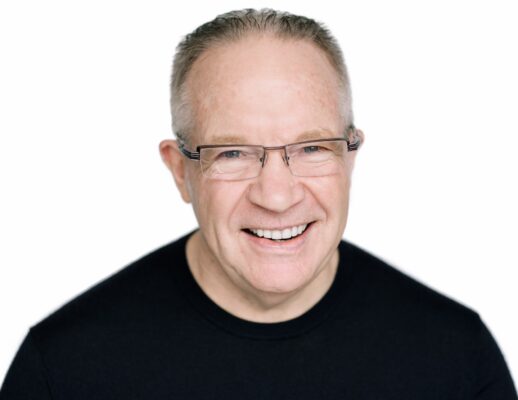 Dan Sullivan is the founder and president of The Strategic Coach Inc., with over 40 years of experience as a speaker, consultant, and coach to entrepreneurs. A visionary and innovator, Dan is committed to helping entrepreneurs maximize their potential through Strategic Coach’s programs, which support both business and personal growth. He has authored over 30 publications, including The Great Crossover and How The Best Get Better®, and co-authored The Laws of Lifetime Growth. Dan and his wife, Babs Smith, co-own and operate The Strategic Coach Inc., with offices in Toronto, Chicago, and the U.K.
Dan Sullivan is the founder and president of The Strategic Coach Inc., with over 40 years of experience as a speaker, consultant, and coach to entrepreneurs. A visionary and innovator, Dan is committed to helping entrepreneurs maximize their potential through Strategic Coach’s programs, which support both business and personal growth. He has authored over 30 publications, including The Great Crossover and How The Best Get Better®, and co-authored The Laws of Lifetime Growth. Dan and his wife, Babs Smith, co-own and operate The Strategic Coach Inc., with offices in Toronto, Chicago, and the U.K.

